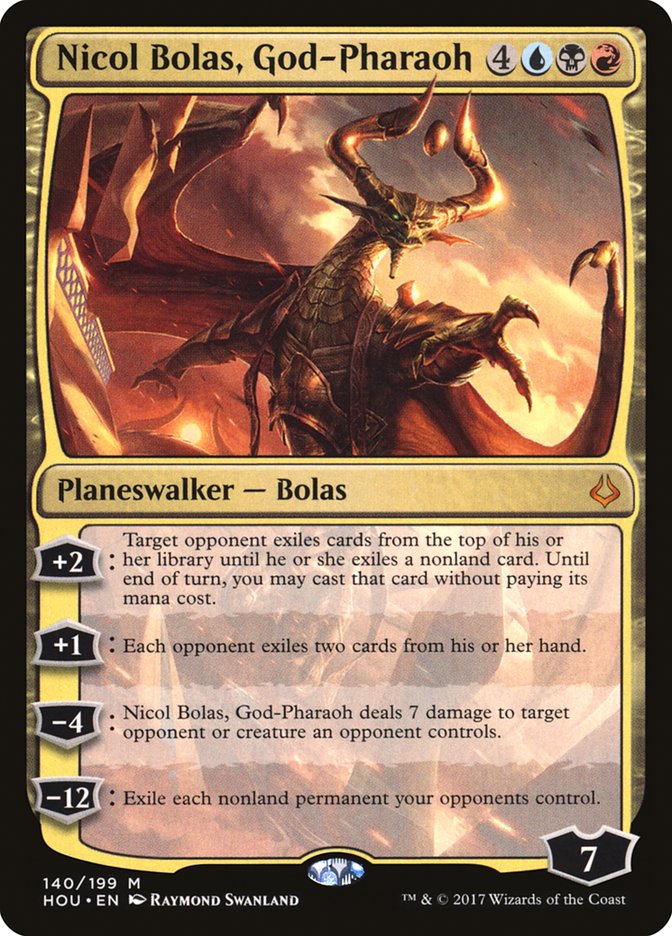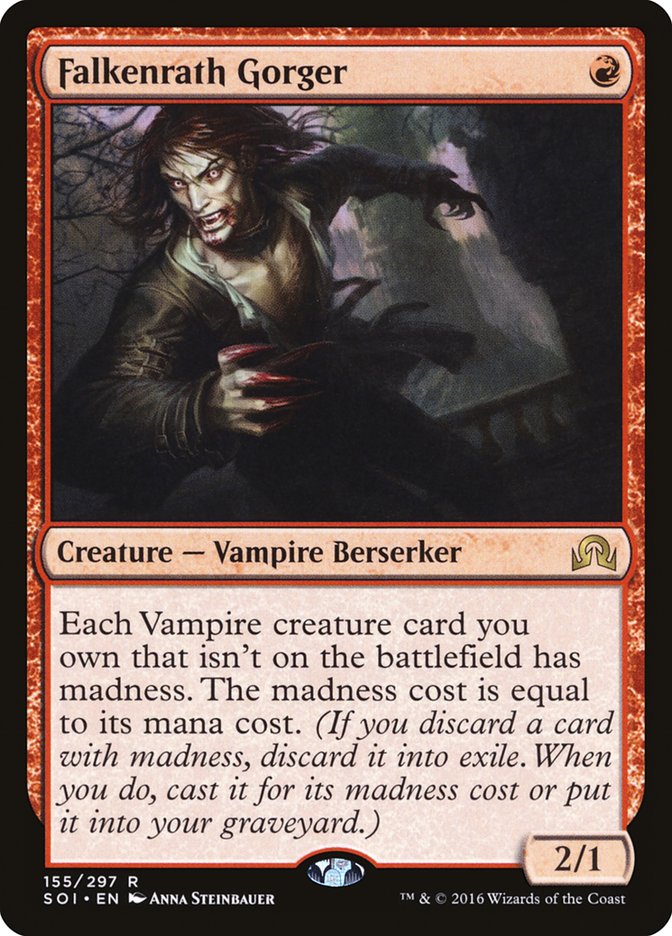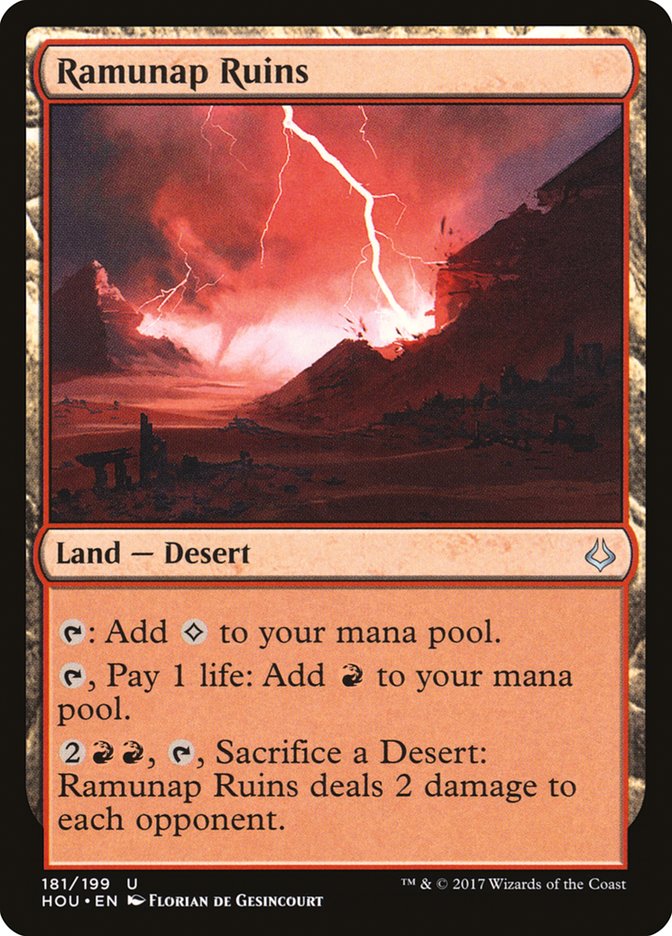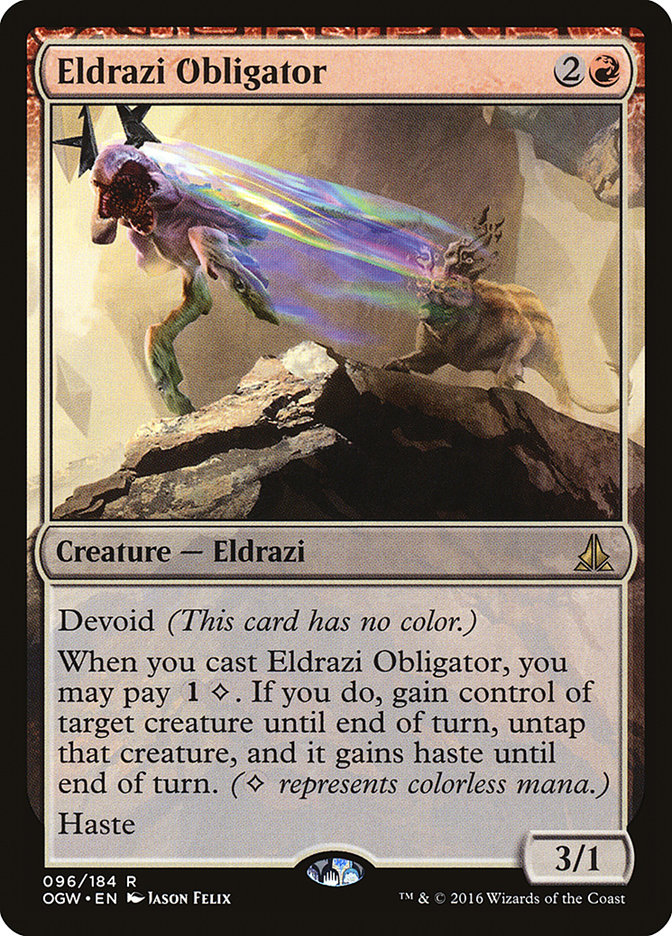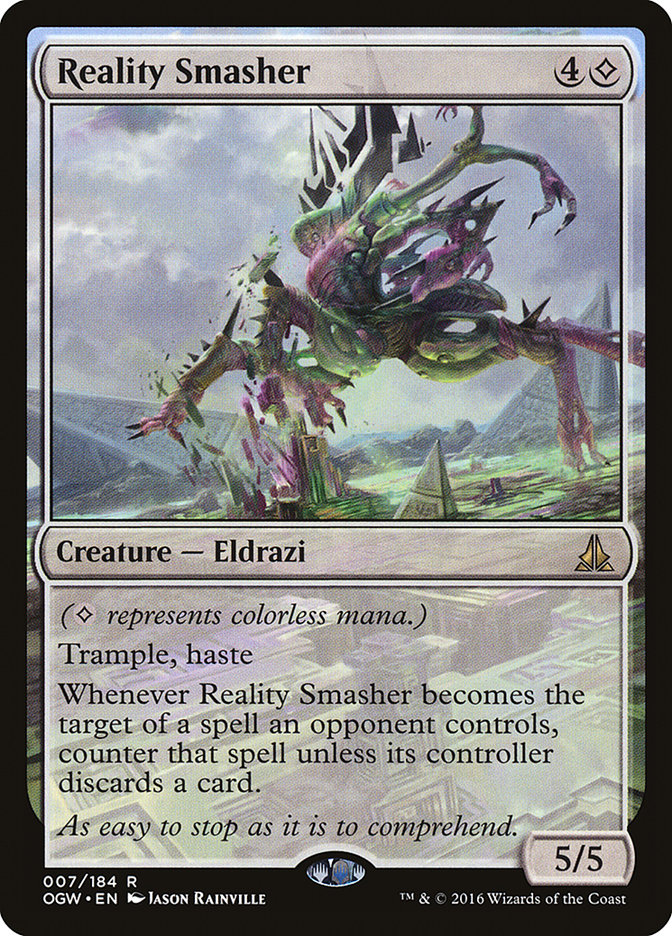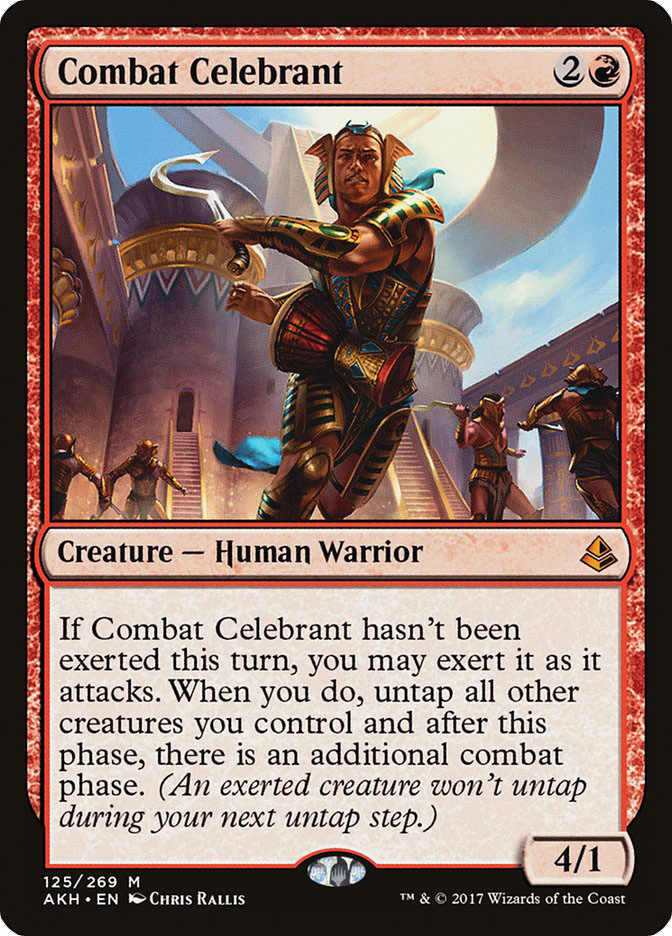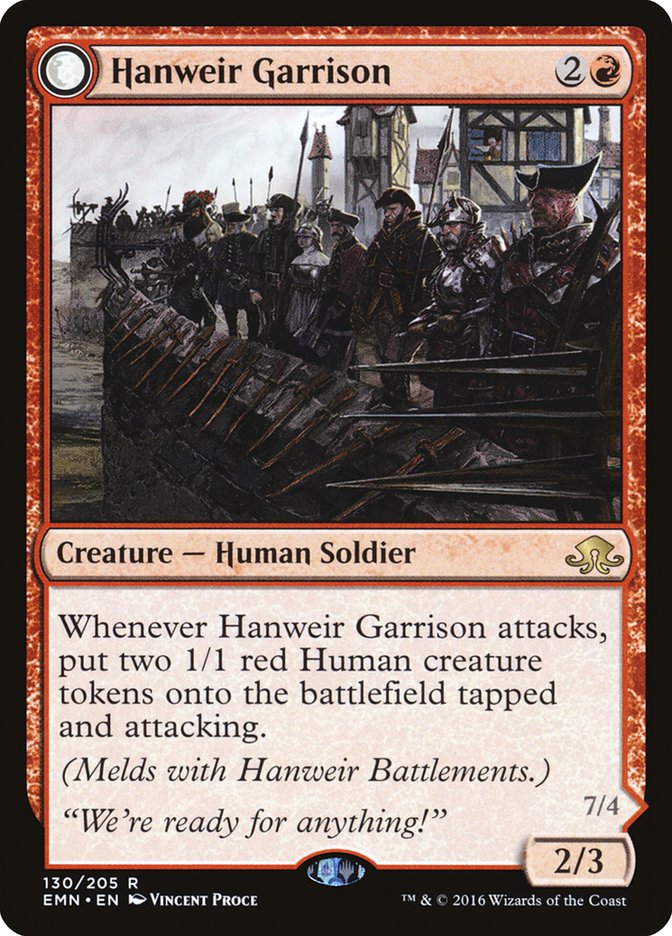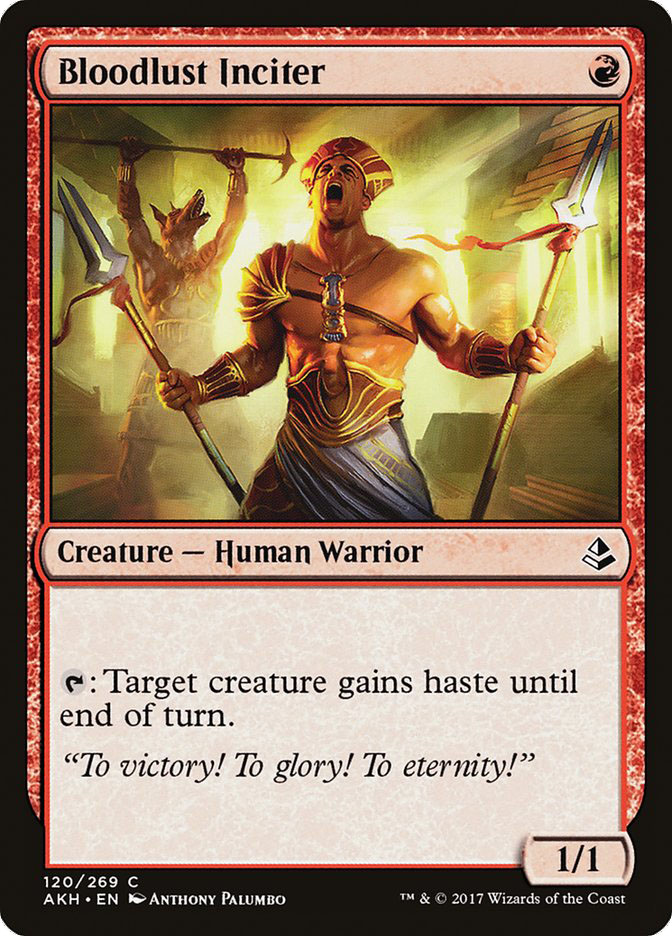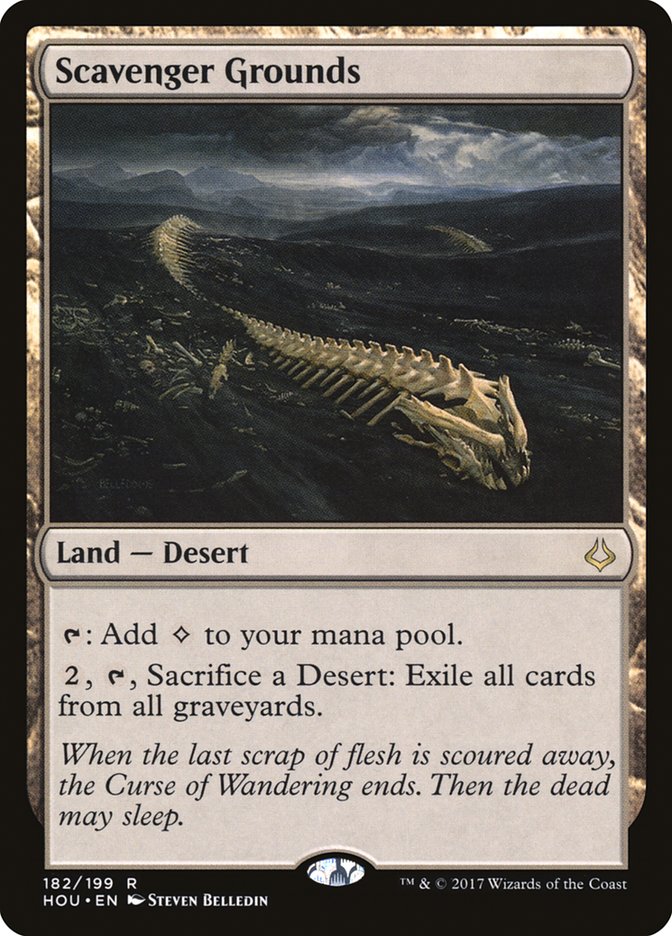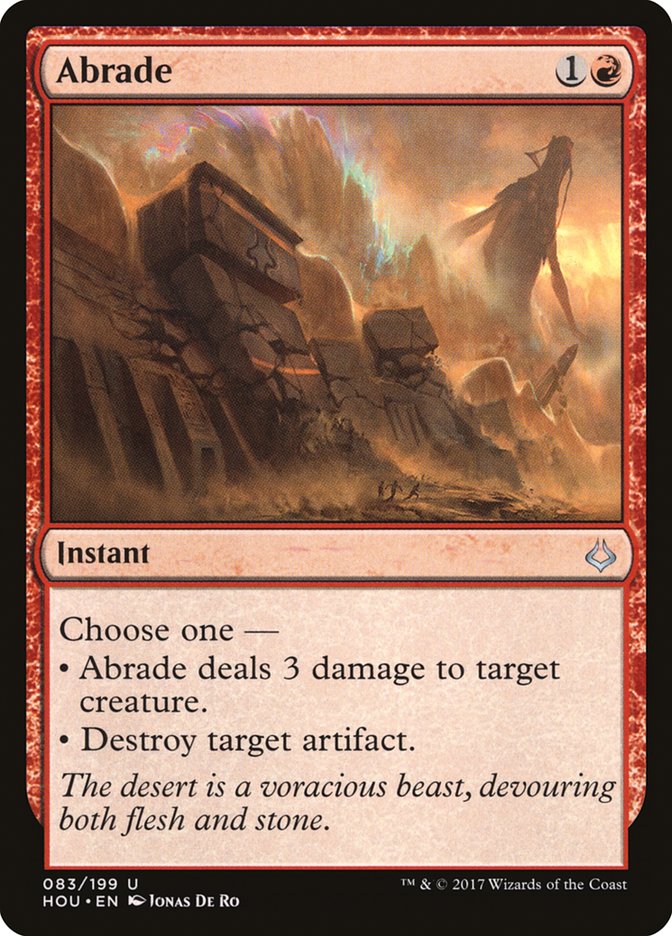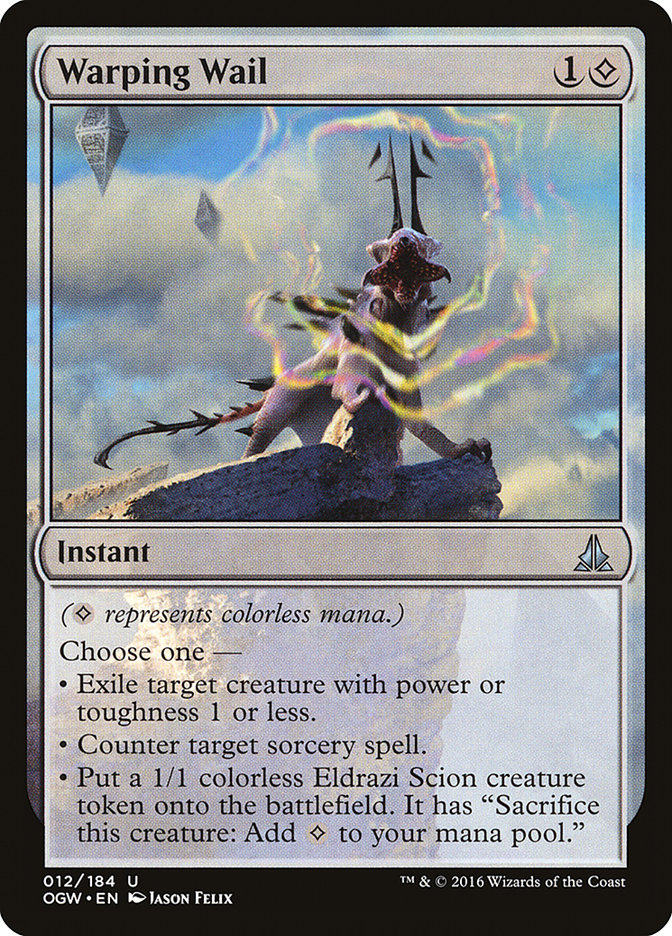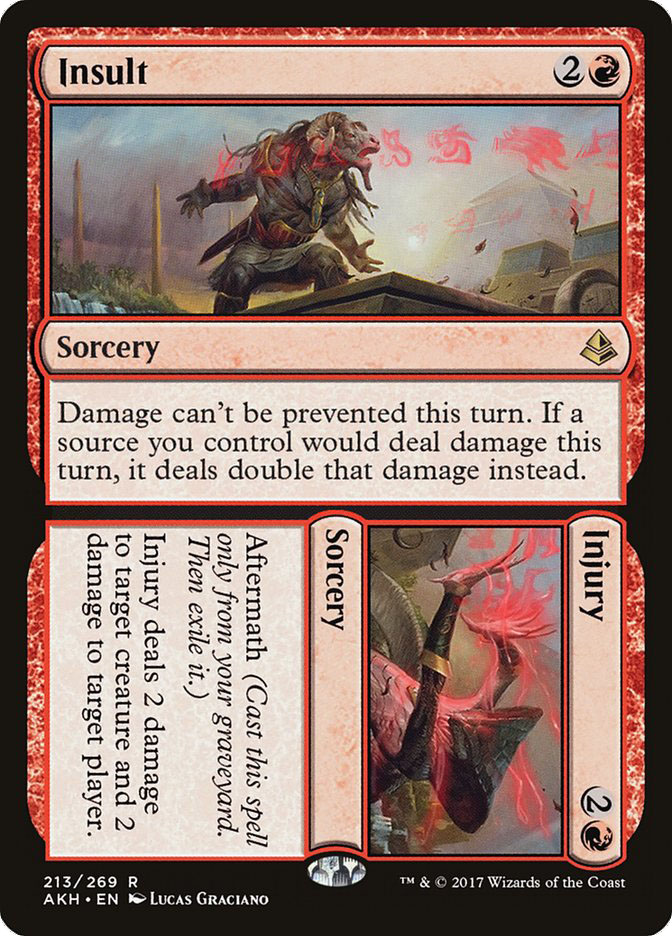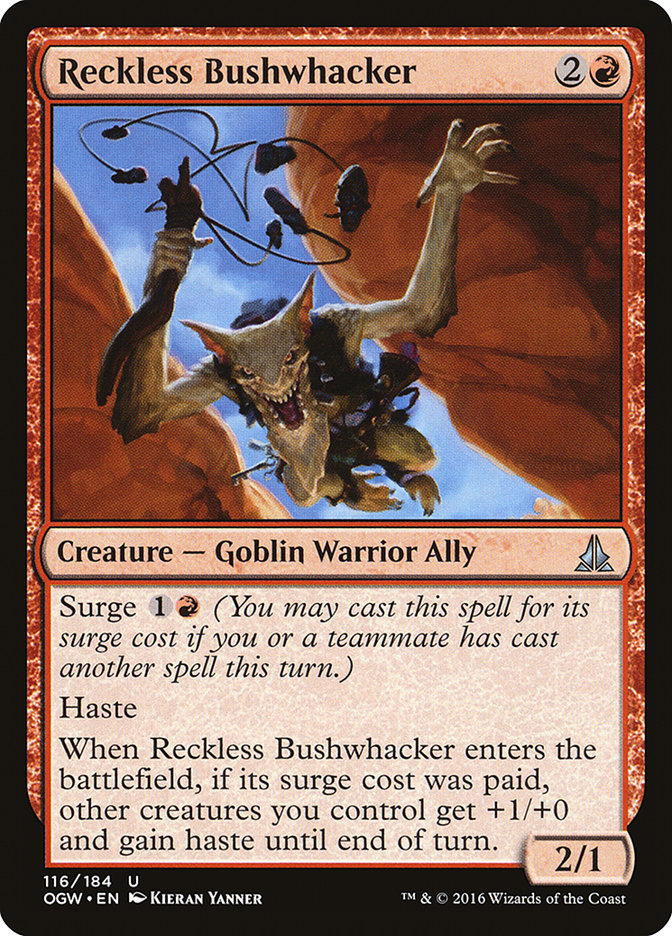With our first tournament down and Hour of Devastation as a set making a real impact, we have our first taste of this set and its influence on the Standard format of the next few months. Unlike most small sets, Hour of Devastation has lots of role-playing pieces and gap-fillers that make new archetypes possible. Deserts have, if you’ll permit me, made a big splash; from Shefet Dunes and its threatened and activated power in the W/U Monument archetype to Ramunap Ruins smacking the last few points of life out of dumbfounded opponents in Mono-Red, this revitalized land type offers a variety of opportunities for deckbuilding and battlefield states both in monocolored and multicolored builds.
Nicol Bolas, God-Pharaoh got to spread his massive wings, too, though not in the quantity and proliferation I expected: only one copy made it into the Top 8. He’s big and bulky, and when we feel uncertain, we fall back on something familiar.
Creatures (23)
- 2 Kalitas, Traitor of Ghet
- 3 Tireless Tracker
- 4 Servant of the Conduit
- 4 Winding Constrictor
- 4 Glint-Sleeve Siphoner
- 4 Walking Ballista
- 2 Dreamstealer
Planeswalkers (6)
Lands (20)
Spells (11)

Stephen Dykman’s expert piloting of an old standby, B/G Energy, proved that Winding Constrictor still gets the job done. With four new cards, two in the main and two in the side, there wasn’t much changed from the deck’s inception.
Some held their arms in even tighter, playing zero new cards, including Adam Bowman’s well-oiled Zombies deck.
Creatures (24)
- 1 Kalitas, Traitor of Ghet
- 4 Relentless Dead
- 4 Diregraf Colossus
- 4 Cryptbreaker
- 3 Metallic Mimic
- 4 Lord of the Accursed
- 4 Dread Wanderer
Lands (24)
- 22 Swamp
- 2 Westvale Abbey
Spells (12)

Don’t get me wrong; making no additions at the dawn of a new set isn’t a bad thing. Frequently, there’s nothing new that can positively or measurably impact the deck’s well-established gameplan. Sometimes, card availability can be a problem, or testing with new cards was not possible. Adam Bowman’s Zombies deck didn’t get any new black Zombies, so no changes. Simple!
But if you folks know me like I hope you do, I’m wondering if you’ll know which of the decks in the SCG Tour lineup interested me most.
Creatures (28)
- 2 Eldrazi Obligator
- 2 Reality Smasher
- 3 Thought-Knot Seer
- 4 Falkenrath Gorger
- 2 Kari Zev, Skyship Raider
- 2 Glorybringer
- 1 Hazoret the Fervent
- 4 Ahn-Crop Crasher
- 4 Soul-Scar Mage
- 4 Earthshaker Khenra
Planeswalkers (2)
Lands (9)
Spells (21)

I watched Jonathan Job play this deck in Round 1 and I kicked myself that I didn’t publish the deck I’d been working on last week.
I’m not sure why, though; these are literally the only cards our maindecks had in common. Well, and Mountain.
Jonathan Job was not only fearless in trying new cards from Hour of Devastation, he reached back before the scope of the majority of mainstream Standard. We think of Battle for Zendikar and Oath of the Gatewatch as sources of Gideon, Ally of Zendikar and Ulamog, the Ceaseless Hunger and…okay, well, that’s about it. However, there’s a rich menagerie of slithering, terrifying, otherworldly creatures oozing out of every corner of that plane, and Jonathan Job wasn’t afraid to tame them for last weekend.
It’s easy to forget; I know I did. Ramunap Ruins, as well as the other uncommon, color-producing Deserts, can also produce colorless. Much like the last cycle of untapped, pinging lands like Caves of Koilos and Shivan Reef, these flexible lands produce colorless and a color at the cost of life, but these Deserts also provide a self-sacrificial bonus ability that ups their profile. The colorless they provide can power these Eldrazi, too, giving an all-new angle to these exciting new lands. Jonathan leveraged that angle effectively, putting “red” creatures into his deck at very little cost and broadening his deck’s overall repertoire from the traditional 2/1s for one mana.
My proudest and most successful God-Pharaoh’s Gift deck to date is also mono-red, and while I love Jonathan’s list, I’m also happy to sport mine in a Standard event. For me, God-Pharaoh’s Gift was the key to longevity with a stream of low-cost creatures meeting better and better quality cards on the battlefield. That, combined with Gate of the Afterlife’s discard trigger, would provide me plenty of juice to stay relevant in the later turns of the game.
In preparation for my first Hour of Devastation tournament, I constructed a mono-red God-Pharaoh’s Gift deck and put it through its paces in Friday Night Magic.
Creatures (31)
- 4 Reckless Bushwhacker
- 4 Falkenrath Gorger
- 4 Insolent Neonate
- 4 Hanweir Garrison
- 4 Stromkirk Occultist
- 4 Furyblade Vampire
- 1 Glorybringer
- 2 Combat Celebrant
- 4 Bloodlust Inciter
Lands (13)
Spells (14)
Sideboard

This deck had two plans. Early on, it would resolve inexpensive threats that greatly benefited from haste. The deck’s best plays would involve Combat Celebrant, which could untap creatures for extra attacks (and triggers, in the case of another Combat Celebrant, Glorybringer, or Hanweir Garrison). Then, once I’d gotten within range, Ramunap Ruins could finish the job by throwing a Desert at their face. Straightforward, consistent and easy to assemble.
Alternatively, if the game went long, God-Pharaoh’s Gift, which makes all my silly 1/1s and 2/1s relevant again, could come back from the graveyard, ready to fight again at a more intimidating size. Combat Celebrant, if reanimated, would also allow a second combat, which means another reanimated target. More heat and pressure can’t be wrong!
Gate to the Afterlife also has a lifegain clause, which is more relevant than you think; every Hour of Devastation, Bontu’s Last Reckoning, or Fumigate caused me to gain life as well. Mono-red decks are used to a zero-benefit sweeper. Here, though, even with an empty hand I could draw and discard, getting me closer to an active Gate to the Afterlife, ready to activate at a hair trigger.
Dr. Strangedeck and How I Learned to Love the Gate
The deck was suited up just in time for FNM against some of our shop’s best players. Everyone was testing for the Cincinnati SCG Tour Standard event, just two hours’ drive from Louisville. The deck I had, while similar to my Hazoret’s Monument list from several weeks ago, featured a slightly different plan. I wasn’t trying to keep a low hand size to maximize Hazoret the Fervent. This one cared less about discard and more about cards dying in general.
Each match was against a player looking to play to win. No freebies tonight.
Round 1 – Grixis Control
My first opponent was on Grixis Control, but he struggled with his mana and resolving relevant threats. After stalling on mana a few turns into each game, I smashed him down two games to none. As a side note, he busted out his B/W Hidden Stockpile deck and thrashed me. But, shhh….
1-0
Round 2 – Four-Color Delirium
My second round was against a friend whose delirium deck wasn’t going to pull any punches as he went for the biggest, more powerful plays he could out of his graveyard. After a nailbiting Game 2 where he stabilized at low life, I couldn’t resolve the last, unblocked creature to close out the game. Game 3 was less of a fight, and I conceded, content to lose to a pal but puzzled to consider how best I beat a deck like his.
1-1
Round 3 – U/W Flash
While I was disheartened by a loss, the deck change to accommodate that matchup was crystal-clear, but more on that at a moment.
In round 3, I battled an opponent on a U/W Flash list, sporting Spell Queller and friends. That being said, after losing the roll to him, he promptly locked my entire deck down with a measly Thalia, Heretic Cathar. With no maindeck removal outside of a single Glorybringer, I crumbled into nothing. No haste. All of my Deserts are tapped Deserts. Blech.
I had plenty of sideboard options for him, though, and Games 2 and 3 were much more decidedly in my favor after he struggled to stabilize against an army of low-cost creatures backed with slender spot removal.
2-1
Round 4 – Four-Color Delirium
All-but-red delirium was on tap in my next match, piloted by one of the shop’s top players. Although I got him to lethal range (two life and three life, respectively), a timely Nissa’s Renewal saved him in Game 1 and Linvala, the Preserver reanimated by Bruna, the Fading Light saved him in Game 2. I still almost got him both times, with a Ramunap Ruins just a turn too late the first time around. He actually flipped both angels into Brisela, Voice of Nightmares in Game 2 before I reluctantly scooped.
2-2
Not the night I’d hoped for, but the gaping holes in my deck could soon be accounted for.
Round 5 – Jund Vehicles
My opponent in the final round produced a potentially dangerous Heart of Kiran and some Fatal Pushes to keep me at bay in Game 1, but soon my single Glorybringer decided the game. In Game 2, I got my perfect start: turn 1 Bloodlust Inciter; turn 2 Furyblade Vampire, discard and attack for four; turn 3 Combat Celebrant, give it haste, attack and discard to hit for eight, untap, attack and discard again to hit for seven. My opponent was at two, and with an empty hand and active Hostile Desert on the field, no amount of removal or blockers could save him.
3-2
A healthy win and three prize boosters later, and I was retuning the deck to fix its flaws.
My build had little game against a delirium deck if it managed to get established. Destroying a graveyard would eliminate the hard work of cards like Champion of Wits, Grapple with the Past, and even Mindwrack Demon. Can you imagine giving someone an empty graveyard after resolving Mindwrack’s mill trigger? They’re taking four a turn against a burn deck!
While counterintuitive, considering my own plan of filling the graveyard with cards for Hostile Desert and Gate to the Afterlife, the incremental potential I gain is considerably worse than the primary gameplan of a delirium or other graveyard-based deck. I have many Deserts to sacrifice to it, so unlike something like Crook of Condemnation, which is a little more precise, this can be repeated given sufficient land.
Heaven // Earth seemed excellent in principle: sweep the battlefield, fill my own graveyard, and trigger Gate to the Afterlife, getting my closer to God-Pharaoh’s Gift. In the end, though, I just needed some good old-fashioned removal, and Abrade’s got my number. My second-round opponent sold me on Abrade. It targets Bristling Hydra with the energy counters trigger on the stack; Gisela, the Broken Blade; Torrential Gearhulk before it blocks; or a Spell Queller. As we all know now, it also kills Oketra’s Monument. This was the perfect choice to answer this deck’s problems in the removal department.
Insult // Injury was a card I’d tested with before and had found to be a bit mediocre. In this deck, though, when I’d often discard it anyway, it had potential to provide both removal and a way to close the game. It was startling, especially in first games, how close to dead my opponents got. In a format of shocklands or fetchlands, they’d have been toast. The piddly two damage, accessible at nearly any time after my hand is spent, is worth a slot.
Warping Wail, while a bit cutesy and “gotcha”-y, solves some of this deck’s problems. Making a 1/1 isn’t super, but hiding a mana in a creature may be just the ticket for the next step. It provides the reduction you might need to get to Glorybringer a turn early and take over the game. It can block that terrifying Elder Deep-Fiend. It can exile that nauseating 1/2 Spider with reach. Perhaps most importantly, it can counter Hour of Devastation, Traverse the Ulvenwald, or even a backbreaking Cathartic Reunion.
I hate to say it, but this card was a wreck.
In my original Hazoret’s Monument deck, with the constant discard and cost reduction of our creature base, Reckless Bushwhacker was foundational. With Hazoret’s Monument and its surge cost online, this creature could enter the battlefield for a single red mana and make that newly cast team an incredible threat. Now, though, it was an absolute dud 99% of the time. It did not make a clean port into this list despite its apparent synergies.
For the second week of this format, here’s the list I’ll be suiting up.
Creatures (27)
- 4 Falkenrath Gorger
- 4 Insolent Neonate
- 2 Hanweir Garrison
- 4 Stromkirk Occultist
- 4 Furyblade Vampire
- 2 Glorybringer
- 3 Combat Celebrant
- 4 Bloodlust Inciter
Lands (14)
Spells (19)
Sideboard

This reflects some additional testing, specifically against U/R Control, which this deck could otherwise just not beat. Hazoret’s Favor proved excellent in testing. Your opponent must leave both countermagic and removal or Wandering Fumarole mana up (which Warping Wail exiles on either side, by the way.)
This deck doesn’t change the original plan; it just prepares for everyone else’s, too.
***
I don’t normally do this much detail in a deck report. Is this something you enjoy, or do you prefer the more esoteric, mental exercise of brewing a couple of different drafts?
This past weekend, I finally did what I’m sure I should have done a long time ago and joined the Twittersphere; on my feed, I’ll be discussing card interactions I find, happenings in the world of Magic and providing unsolicited commentary on the formats we all love to play. You can follow me using the new link in my bio!
Love the Gate!


